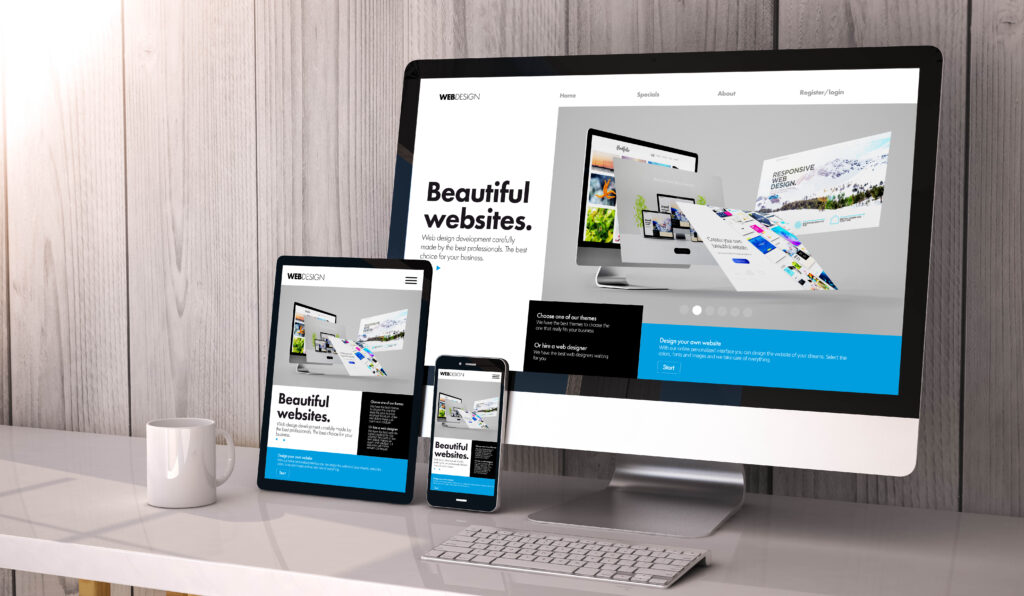Introduction to the Site Creator
In the current digital era, a website is indispensable for any business, whether a small local shop or a sprawling multinational company. Entrepreneurs and small business owners alike may find the idea of creating a website intimidating. Thankfully, modern technology provides a straightforward answer: a Website Builder that crafts user-friendly websites in under an hour. This revolutionary tool democratizes website creation, ensuring it is accessible to anyone, no matter their level of technical expertise.
The evolution of website builders has made it possible for businesses to establish their online presence rapidly and efficiently. A Website Builder creates websites by providing pre-designed templates and intuitive tools that simplify the entire process. Users can select from various designs tailored to different industries and purposes, ensuring that the final product aligns perfectly with their business objectives. This makes it especially advantageous for those who may not have the budget to hire professional web designers or developers.
A significant advantage of using a Website Builder is the speed at which you can go from concept to live website. Traditional website development can take weeks or even months, often requiring numerous revisions and extensive back-and-forth communication between the client and the developer. In contrast, a website builder allows you to oversee every aspect of your site’s development in real-time, making adjustments as needed and seeing immediate results. This not only saves time but also puts you in full control of your website’s appearance and functionality.
Another key feature of modern Website Builders is their ease of use. These tools are designed with the end user in mind, featuring drag-and-drop interfaces that require no coding knowledge. This user-centric approach ensures that even those with minimal technical background can produce a professional-looking website. Additionally, most website builders offer a range of customisation options, from font and colour selection to the integration of multimedia elements, allowing users to create a website that genuinely reflects their brand.
Moreover, these tools are equipped with built-in functionalities that enhance the overall performance and reach of your website. SEO tools, for instance, help optimise your site for search engines, increasing its visibility to potential customers. Analytics features enable you to monitor your site’s performance, offering insights into visitor behaviour and helping you make informed decisions about future updates and content strategies. Such features are invaluable for businesses aiming to grow their online presence and engage more effectively with their audience.
Accessibility is another critical factor that makes website builders appealing. They offer a cost-effective solution, with pricing plans that cater to different budgets. Whether you are a start-up on a tight budget or an established business looking to expand your digital footprint, there is likely a website builder plan that fits your needs. Most plans include web hosting and domain registration, further simplifying the process by consolidating all necessary services under one roof.
In summary, the advent of website builders has transformed the landscape of website creation. They offer an efficient, user-friendly, and cost-effective means of developing a professional online presence, allowing businesses to focus on what they do best while leaving the technicalities of website building to the intuitive tools provided by these platforms.
Getting Started
Beginning your journey with a website builder is straightforward and stress-free. Most Website Builders come with a monthly fee ranging from £10 to £50, which often includes web hosting and domain registration (£10 to £50 per month typically covers web hosting and domain registration.).
Before you dive in, it’s essential to determine your website’s purpose and target audience, as this will guide your design choices. Are you creating a site for a local business, an online portfolio, or perhaps an e-commerce platform? Understanding the primary goal of your website will help you choose the right templates and features.
Once you have a clear vision, the next step is to choose a website builder that aligns with your requirements and budget. Several options are available, each with unique features tailored to different needs. Research the different platforms and read user reviews to find the one that best suits your project.
After selecting your preferred website builder, you’ll typically start by signing up for an account. Most builders offer a free trial period, allowing you to explore their features before committing financially. This trial period is an excellent opportunity to get a feel for the interface and ensure it meets your needs.
Following account creation, you’ll be prompted to choose a template. These templates serve as the foundation of your website and can be customised to match your brand’s identity. It’s advisable to select a template designed for your industry to ensure the layout and features align with your business objectives.
Customising your chosen template is where you can truly make your website unique. Website Builders provide various tools and options to personalise your site. You can adjust colours, fonts, and layouts, and add elements such as images, videos, and contact forms. Drag-and-drop functionality simplifies this process, allowing you to see changes in real-time.
Adding content is the next critical step. Prepare text, images, and other media in advance to streamline this process. Ensure your content is clear, engaging, and relevant to your audience. High-quality content not only improves user experience but also boosts your site’s search engine optimisation (SEO).
Many Website Builders also offer additional features to enhance your site. For instance, SEO tools can help optimise your website for search engines, increasing its visibility. Analytics tools provide insights into visitor behaviour, helping you make data-driven decisions to improve your site.
Once your content is in place, it’s time to preview your website. Most builders allow you to see how your site will look on different devices, ensuring a responsive design that works well on both desktop and mobile platforms. Make any necessary adjustments to ensure a seamless user experience.
Finally, before publishing, review your site for any errors or omissions. Check links, test forms, and ensure all elements function correctly. This final review step is crucial to presenting a polished and professional website to your audience.
User-Friendly Interface
The hallmark of modern Website Builders is their user-centric interface, designed to make the website creation process as seamless as possible. These tools are crafted with the understanding that not everyone is a seasoned web developer; hence, they offer an intuitive experience that caters to individuals with varying levels of technical knowledge.
The drag-and-drop functionality is one of the standout features that greatly simplifies the design process. Users can effortlessly add, move, and resize elements on their web pages by simply dragging them into place. This eliminates the need for any coding skills, allowing even complete beginners to create professional-looking websites. The pre-set layouts further enhance this ease of use, offering structured designs that can be customised to suit individual preferences.
Another feature that contributes to the user-friendly nature of these builders is the real-time editing capability. As you make changes to your website, you can see them instantly, which allows for a more dynamic and interactive design process. This real-time feedback is invaluable, enabling you to experiment with different layouts, colours, and fonts without committing to any changes until you are completely satisfied.
The intuitive design of these interfaces extends to their navigation menus and toolbars, which are often streamlined to prevent any clutter. This ensures that all necessary tools and options are readily accessible, eliminating any potential confusion and making the design process more straightforward. The inclusion of tooltips and guides within the interface also provides additional support, helping users understand the functionalities of different tools.
Furthermore, many Website Builders offer a range of tutorial videos and step-by-step guides, which can be extremely helpful for new users. These resources walk you through the entire process, from selecting a template to customising your website and adding content. This educational support ensures that you can take full advantage of all the features available, enhancing your overall experience.
Mobile responsiveness is another key aspect of user-friendly Website Builders. As more people access the internet via mobile devices, ensuring that your website looks and functions well on smartphones and tablets is crucial. Many builders automatically optimise your website for mobile viewing, sparing you the hassle of creating separate versions for different devices. This ensures a consistent and professional appearance across all platforms.
Finally, accessibility features are often integrated into these tools, allowing users to create websites that are inclusive and accessible to people with disabilities. Options like alt text for images, keyboard navigation, and screen reader compatibility are standard, ensuring that your website can reach a broader audience.
By focusing on user-centric design, modern Website Builders make the process of creating a website not only manageable but also enjoyable, empowering anyone to establish an online presence with ease.
Customisation Options
One of the standout features of contemporary Website Builders is the extensive range of customisation options they offer. With a plethora of templates and design choices, users can tailor their websites to meet specific needs. For example, “Squarespace features a lot of great templates.” – . Personalisation is simple, allowing you to adjust colours, fonts, and layouts to reflect your brand’s identity. This flexibility ensures that your website stands out and meets your unique vision.
Customisation options extend beyond mere aesthetics. Users can incorporate various functionalities that enhance user experience and interactivity. Many website builders offer built-in widgets and plugins, such as contact forms, social media integrations, and e-commerce capabilities. These features can be easily added to your site, enabling you to offer a richer, more engaging experience for your visitors.
For businesses, the ability to customise your website’s functionality is invaluable. You can add booking systems, payment gateways, and customer support chatbots, all without needing advanced technical skills. This means you can cater to your specific business needs, whether you are running an online shop, a local service provider, or a portfolio site.
Moreover, customisation extends to the back-end of your website. Advanced settings allow you to optimise your site’s performance, from setting up redirects to managing SEO metadata. These tools are crucial for ensuring your website runs smoothly and ranks well on search engines. You can also customise your website’s URL structure and implement analytics tracking codes, providing you with the data you need to refine your digital strategy.
Customising your website also involves selecting the right multimedia elements. Website Builders support a range of media formats, allowing you to upload images, videos, and audio files. High-quality visuals and engaging multimedia can significantly enhance your website’s appeal, making it more attractive to visitors. Many builders offer image editing tools and video embedding options, enabling you to present your content in the most compelling way possible.
In terms of user interface, customisation is made easy through drag-and-drop features and real-time previews. As you personalise your site, you can see the changes instantly, allowing you to experiment with different designs without any commitment. This interactive approach makes it easy to fine-tune your website until it perfectly matches your vision.
Lastly, responsive design options ensure your customisations look great on all devices. Most Website Builders automatically adjust your site’s layout for mobile and tablet viewing, so you don’t have to create separate versions for different devices.
Efficient Workflow
Website Builders streamline the process of creating a website by offering a straightforward and efficient workflow. The initial step involves selecting a template that suits your business or personal needs. These templates are professionally designed and cater to various industries, ensuring that you start with a solid foundation.
After choosing a template, the next phase is customisation. Website Builders provide an array of options to tailor the design to your preferences. You can adjust colours, fonts, and layouts to reflect your brand’s identity. The drag-and-drop interface makes it easy to add and move elements around the page, allowing for a highly personalised and visually appealing website without any coding skills.
Content addition follows the customisation stage. This involves uploading images, videos, and text that will populate your site. Many Website Builders offer tools to optimise your media files, ensuring that they load quickly and appear high-quality across all devices. Preparing your content in advance can streamline this process, making it quicker to get your site ready for publication.
An important aspect of the workflow is the integration of built-in features. SEO tools, for example, help optimise your website for search engines, improving its visibility to potential visitors. Analytics tools enable you to track user behaviour and gather insights that can inform future updates. These built-in functionalities save time and eliminate the need for third-party plugins, simplifying the overall management of your site.
Furthermore, most Website Builders offer various widgets and plugins to enhance user experience. These can include contact forms, social media buttons, and e-commerce capabilities, all of which can be easily added to your site. The ability to integrate these features seamlessly into your website enhances its functionality and user engagement.
Another advantage is the real-time preview option. As you make changes, you can see them instantly, which allows for a more dynamic design process. This real-time feedback is invaluable, enabling you to experiment with different layouts and features until you are completely satisfied.
The workflow is also designed to ensure mobile responsiveness. Many Website Builders automatically adjust your site’s layout for optimal viewing on smartphones and tablets. This is crucial in today’s mobile-first world, where a significant portion of web traffic comes from mobile devices.
By focusing on these streamlined steps—template selection, customisation, content addition, feature integration, and real-time preview—website builders make the process of creating a professional, user-friendly website both efficient and enjoyable.
Publishing and Maintenance
After finalising your website’s design and content, the next step is to publish it, which can be done with just a click. This feature is particularly beneficial for those who need to get their site online quickly without any hassle. Once your site is live, it’s important to focus on regular maintenance to ensure it remains functional and engaging for visitors.
Regular updates are crucial for maintaining your site’s relevance and performance. One of the first things to keep an eye on is the software updates for your Website Builder. Most builders will notify you of any available updates, which often include new features, security patches, and performance improvements. Keeping your builder’s software up to date helps protect your site from vulnerabilities and ensures it runs smoothly.
Another important aspect of maintenance is monitoring your site’s analytics. These insights can provide valuable information about your visitors’ behaviour, helping you understand which areas of your site are performing well and which might need improvement. By regularly reviewing your analytics, you can make informed decisions about content updates and marketing strategies. This data-driven approach ensures your site continues to meet the needs and expectations of your audience.
Content updates are equally essential. Fresh, engaging content keeps visitors returning to your site and can improve your search engine rankings. Whether it’s blog posts, news updates, or new product listings, regularly adding new content shows that your site is active and current. It’s also a good practice to periodically review existing content to ensure it’s still relevant and accurate.
In addition to content updates, consider adding new features or functionalities as your business evolves. Most website builders offer a range of plugins and widgets that can be easily integrated into your site. Whether you want to add an e-commerce section, a booking system, or social media feeds, these additions can enhance user experience and keep your site aligned with your business goals.
Another key maintenance task is checking for broken links and outdated information. Broken links can frustrate visitors and harm your site’s credibility, so it’s essential to test all links periodically. Tools are available to help automate this process, making it easier to identify and fix any issues quickly.
Finally, ensure your site remains mobile-friendly. As more users access websites via mobile devices, it’s vital that your site offers a seamless experience across all platforms. Most modern website builders automatically adjust your site’s layout for mobile viewing, but it’s still a good idea to test your site on various devices to ensure everything functions as intended. Regularly reviewing and updating your mobile design will keep your site accessible and user-friendly for all visitors.
Conclusion
Website Builders have revolutionised the process of creating an online presence, making it accessible to individuals and businesses regardless of their technical expertise. The efficiency of these tools, allowing the creation of a professional website in less than an hour, is a significant advantage. This rapid development capability means that businesses can quickly adapt to market demands and launch timely campaigns or updates.
The user-centric design of modern Website Builders ensures that even those without any coding knowledge can produce visually appealing and functional websites. The drag-and-drop interfaces, combined with a wide range of templates and customisation options, make the design process both intuitive and enjoyable. This empowerment of users to take control of their online presence without the need for professional web designers or developers can result in substantial cost savings.
Moreover, the built-in functionalities, such as SEO tools and analytics, enhance the overall performance of the website, making it easier to attract and retain visitors. These tools provide valuable insights into visitor behaviour and website performance, enabling informed decisions that can drive business growth.
Regular maintenance, facilitated by the user-friendly interfaces of Website Builders, ensures that the site remains current and engaging. With features such as automatic software updates and easy content management, maintaining a professional online presence becomes a straightforward task. This ease of use means that businesses can focus on their core activities, knowing that their website will continue to perform well and meet their needs.
Additionally, the affordability of Website Builders, with various pricing plans to suit different budgets, makes them an attractive option for businesses of all sizes. The inclusion of essential services like web hosting and domain registration in these plans further simplifies the process, reducing the need for additional service providers.
In essence, the flexibility, efficiency, and cost-effectiveness of Website Builders make them an invaluable tool for anyone looking to establish or enhance their online presence. The ability to swiftly create and maintain a professional website ensures that businesses can stay competitive in the digital age. Whether you are a start-up looking to make your mark or an established business aiming to expand your reach, website builders offer a practical and powerful solution for all your web development needs.



